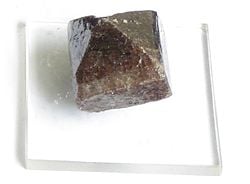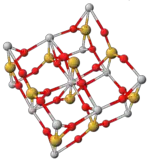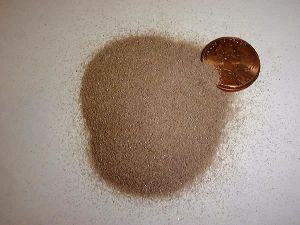Difference between revisions of "Zircon" - New World Encyclopedia
(claimed) |
|||
| Line 31: | Line 31: | ||
}} | }} | ||
| − | '''Zircon''' is a [[mineral]] belonging to | + | '''Zircon''' is a [[mineral]] belonging to a subgroup of [[silicate minerals]] called nesosilicates. Chemically, it is known as [[zirconium]] [[silicate]], with the formula [[Zirconium|Zr]][[Silicon|Si]][[Oxygen|O]]<sub>4</sub>. Although its [[crystal]]s are seldom large, zircon is remarkable in that it is nearly ubiquitous in the [[Earth]]'s crust. Its natural color varies from colorless to golden yellow, red, brown, green, and black. Colorless specimens of gem quality are a popular substitute for [[diamond]] and are known as "Matura diamond." It should be noted, however, that [[cubic zirconia]] is an entirely different synthetic substance with a different chemical composition. |
| + | |||
| + | == Etymology == | ||
The name derives from the [[Arabic language|Arabic]] word ''zarqun'', meaning [[vermilion]], or perhaps from the [[Persian language|Persian]] ''zargun'', meaning golden-colored. These words are corrupted into "jargoon", a term applied to light-colored zircons. Yellow zircon is called '''hyacinth''', from a word of East Indian origin; in the Middle Ages all yellow stones of East Indian origin were called hyacinth, but today this term is restricted to the yellow zircons. | The name derives from the [[Arabic language|Arabic]] word ''zarqun'', meaning [[vermilion]], or perhaps from the [[Persian language|Persian]] ''zargun'', meaning golden-colored. These words are corrupted into "jargoon", a term applied to light-colored zircons. Yellow zircon is called '''hyacinth''', from a word of East Indian origin; in the Middle Ages all yellow stones of East Indian origin were called hyacinth, but today this term is restricted to the yellow zircons. | ||
| − | Zircon is | + | == Occurrence == |
| + | |||
| + | Zircon is found worldwide as a common accessory mineral. Notable occurrences include the [[Ural Mountains]]; Trentino, Monte Somma, and [[Vesuvius]], [[Italy]]; Arendal, [[Norway]]; [[Sri Lanka]]; [[India]]; [[Thailand]]; [[Ratanakiri]], [[Cambodia]]; the Kimberley mines, [[Republic of South Africa]]; and [[Madagascar]]. In [[Canada]], it is found in Renfrew County, [[Ontario]], and [[Grenville, Quebec]]. In the [[United States]], it occurs in [[Litchfield, Maine]]; [[Chesterfield, Massachusetts]]; Essex, Orange, and St. Lawrence Counties, [[New York]]; [[Henderson County, North Carolina]]; the [[Pikes Peak]] district of [[Colorado]]; and [[Llano County, Texas]]. | ||
== Properties == | == Properties == | ||
| + | [[image:zircon_microscope.jpg|left|150px|thumb|Optical microscope photograph; the length of the crystal is about 250 micrometers.]] | ||
| + | [[Image:Zirconcrystal-model.png|right|150px|thumb|A model of the structure of zircon.]] | ||
| − | + | Zircon is found in [[igneous rock]]s (as primary crystallization products), [[metamorphic rock]]s, and [[sedimentary rock]]s (as detrital grains). The average size of zircon crystals, as in [[granitoid|granite]] rocks, is about 100–300 micrometers (µm), but they can also grow to sizes of several centimeters, especially in [[pegmatite]]s. | |
| − | |||
| − | Zircon | ||
| − | |||
| − | |||
| − | |||
| − | |||
| − | [[ | + | In terms of crystal structure, zircon belongs to the [[tetragonal]] [[crystal class]]. [[Hafnium]] is almost always present, in quantities ranging from 1 to 4 percent. Also, based on their [[uranium]] and [[thorium]] content, some zircons undergo [[metamictization]]. This partially disrupts the crystal structure and explains the highly variable properties of zircon. |
| − | + | [[Thorite]], or thorium silicate (ThSiO<sub>4</sub>), is a related mineral with a similar structure. | |
== Uses == | == Uses == | ||
| − | [[Image:ZirconUSGOV.jpg|thumb|Zircon dust]] | + | [[Image:ZirconUSGOV.jpg|thumb|Zircon dust.]] |
Commercially, zircons are mined for the metal zirconium which is used for abrasive and insulating purposes. It is the source of [[zirconium oxide]], one of the most [[refractory]] materials known. Crucibles of ZrO are used to fuse [[platinum]] at temperatures in excess of 1755 <sup>o</sup>C. Zirconium metal is used in [[nuclear reactors]] due to its [[neutron]] absorption properties. Large specimens are appreciated as [[gemstone]]s, owing to their high [[refractive index]] (zircon has a refractive index of around 1.95, [[diamond]] around 2.4). The color of zircons that do not have gem quality can be changed by heat treatment. Depending on the amount of heat applied, colorless, blue and golden-yellow zircons can be made. | Commercially, zircons are mined for the metal zirconium which is used for abrasive and insulating purposes. It is the source of [[zirconium oxide]], one of the most [[refractory]] materials known. Crucibles of ZrO are used to fuse [[platinum]] at temperatures in excess of 1755 <sup>o</sup>C. Zirconium metal is used in [[nuclear reactors]] due to its [[neutron]] absorption properties. Large specimens are appreciated as [[gemstone]]s, owing to their high [[refractive index]] (zircon has a refractive index of around 1.95, [[diamond]] around 2.4). The color of zircons that do not have gem quality can be changed by heat treatment. Depending on the amount of heat applied, colorless, blue and golden-yellow zircons can be made. | ||
| + | |||
| + | Zircon is regarded as the traditional [[Birthstone#Birthstones|birthstone]] for December. | ||
== Zircons and the age of Earth == | == Zircons and the age of Earth == | ||
[[Image:Zircon crystal.jpg|thumb|A piece of zircon estimated to be the [[Oldest known object on Earth|oldest object]] on Earth]] | [[Image:Zircon crystal.jpg|thumb|A piece of zircon estimated to be the [[Oldest known object on Earth|oldest object]] on Earth]] | ||
| + | |||
The pervasive occurrence of zircon has become more important since the discovery of [[radiometric dating]]. Zircons contain amounts of [[uranium]] and [[thorium]] (from 10 [[Parts per million|ppm]] up to 1 wt%) and can be dated using modern analytical techniques. Since zircons have the capability to survive geologic processes like [[erosion]], transport, even high-grade [[metamorphism]], they are used as [[protolith indicator]]s. | The pervasive occurrence of zircon has become more important since the discovery of [[radiometric dating]]. Zircons contain amounts of [[uranium]] and [[thorium]] (from 10 [[Parts per million|ppm]] up to 1 wt%) and can be dated using modern analytical techniques. Since zircons have the capability to survive geologic processes like [[erosion]], transport, even high-grade [[metamorphism]], they are used as [[protolith indicator]]s. | ||
| Line 64: | Line 67: | ||
==See also== | ==See also== | ||
| − | + | ||
| − | * [[ | + | * [[Gemstone]] |
| − | * [[ | + | * [[Mineral]] |
== Further reading == | == Further reading == | ||
| − | + | ||
| − | |||
* {{cite journal | * {{cite journal | ||
| author = D. J. Cherniak and E. B. Watson | | author = D. J. Cherniak and E. B. Watson | ||
| Line 77: | Line 79: | ||
| journal = Chemical Geology | | journal = Chemical Geology | ||
| volume = 172 | pages = pp. 5-24 | | volume = 172 | pages = pp. 5-24 | ||
| − | |||
| − | |||
| − | |||
| − | |||
| − | |||
| − | |||
| − | |||
| − | |||
| − | |||
| − | |||
| − | |||
| − | |||
| − | |||
| − | |||
}} | }} | ||
* {{cite journal | * {{cite journal | ||
| Line 98: | Line 86: | ||
| journal = Journal of Metamorphic Geology | | journal = Journal of Metamorphic Geology | ||
| volume = 15 | pages = pp. 127-140 | | volume = 15 | pages = pp. 127-140 | ||
| − | |||
| − | |||
| − | |||
| − | |||
| − | |||
| − | |||
| − | |||
| − | |||
| − | |||
| − | |||
| − | |||
| − | |||
| − | |||
| − | |||
| − | |||
| − | |||
| − | |||
| − | |||
| − | |||
| − | |||
| − | |||
| − | |||
}} | }} | ||
* {{cite journal | * {{cite journal | ||
| Line 141: | Line 107: | ||
==References== | ==References== | ||
| − | * | + | |
| − | + | * Hanchar & Hoskin. 2003. ''Zircon. Reviews in Mineralogy and Geochemistry''. vol. 53. Mineralogical Society of America. [http://www.minsocam.org/MSA/RIM/Rim53.html] Retrieved April 4, 2007. | |
| − | * | + | |
| − | * | + | * Farndon, John. 2006. ''The Practical Encyclopedia of Rocks & Minerals: How to Find, Identify, Collect and Maintain the World's best Specimens, with over 1000 Photographs and Artworks''. London: Lorenz Books. ISBN 0754815412 and ISBN 978-0754815419. |
| − | * | + | |
| + | * Klein, Cornelis, and Barbara Dutrow. 2007. ''Manual of Mineral Science''. 23rd ed. New York: John Wiley. ISBN 0471721573 and ISBN 978-0471721574. | ||
| + | |||
| + | * Pellant, Chris. 2002. ''Rocks and Minerals''. Smithsonian Handbooks. New York: Dorling Kindersley. ISBN 0789491060 and ISBN 978-0789491060. | ||
| + | |||
| + | * Shaffer, Paul R., Herbert S. Zim, and Raymond Perlman. 2001. ''Rocks, Gems and Minerals''. Rev. ed. New York: St. Martin's Press. ISBN 1582381321 and ISBN 978-1582381329. | ||
==External links== | ==External links== | ||
| − | + | * [http://www.geology.wisc.edu/zircon/zircon_home.html Geochemistry of old zircons.] Retrieved April 4, 2007. | |
| + | * [http://mineral.galleries.com/minerals/silicate/zircon/zircon.htm Mineral galleries.] Retrieved April 4, 2007. | ||
| + | * [http://webmineral.com/data/Zircon.shtml Webmineral.] Retrieved April 4, 2007. | ||
| + | * [http://www.mindat.org/min-4421.html Mindat.] Retrieved April 4, 2007. | ||
[[Category:Physical sciences]] | [[Category:Physical sciences]] | ||
Revision as of 06:05, 4 April 2007
| Zircon | |
|---|---|
 Zircon crystal from Tocantins, Brazil |
|
| General | |
| Category | Mineral |
| Chemical formula | zirconium silicate ZrSiO4 |
| Identification | |
| Color | brown, red, yellow, green, black, and colorless |
| Crystal habit | dipyramidal prismatic |
| Crystal system | Tetragonal; 4/m 2/m 2/m |
| Cleavage | indistinct, two directions |
| Fracture | Subconchoidal to uneven - brittle |
| Mohs Scale hardness | 7.5 |
| Luster | Adamantine |
| Refractive index | nω=1.967 - 2.015 nε=1.920 - 1.960 |
| Birefringence | δ=0.047 - 0.055 |
| Streak | White |
| Specific gravity | 4.6–4.7 |
| {{{density}}} | |
| Fusibility | Infusible |
| Solubility | Insoluble |
| Other Characteristics | Fluorescent and radioactive |
Zircon is a mineral belonging to a subgroup of silicate minerals called nesosilicates. Chemically, it is known as zirconium silicate, with the formula ZrSiO4. Although its crystals are seldom large, zircon is remarkable in that it is nearly ubiquitous in the Earth's crust. Its natural color varies from colorless to golden yellow, red, brown, green, and black. Colorless specimens of gem quality are a popular substitute for diamond and are known as "Matura diamond." It should be noted, however, that cubic zirconia is an entirely different synthetic substance with a different chemical composition.
Etymology
The name derives from the Arabic word zarqun, meaning vermilion, or perhaps from the Persian zargun, meaning golden-colored. These words are corrupted into "jargoon", a term applied to light-colored zircons. Yellow zircon is called hyacinth, from a word of East Indian origin; in the Middle Ages all yellow stones of East Indian origin were called hyacinth, but today this term is restricted to the yellow zircons.
Occurrence
Zircon is found worldwide as a common accessory mineral. Notable occurrences include the Ural Mountains; Trentino, Monte Somma, and Vesuvius, Italy; Arendal, Norway; Sri Lanka; India; Thailand; Ratanakiri, Cambodia; the Kimberley mines, Republic of South Africa; and Madagascar. In Canada, it is found in Renfrew County, Ontario, and Grenville, Quebec. In the United States, it occurs in Litchfield, Maine; Chesterfield, Massachusetts; Essex, Orange, and St. Lawrence Counties, New York; Henderson County, North Carolina; the Pikes Peak district of Colorado; and Llano County, Texas.
Properties
Zircon is found in igneous rocks (as primary crystallization products), metamorphic rocks, and sedimentary rocks (as detrital grains). The average size of zircon crystals, as in granite rocks, is about 100–300 micrometers (µm), but they can also grow to sizes of several centimeters, especially in pegmatites.
In terms of crystal structure, zircon belongs to the tetragonal crystal class. Hafnium is almost always present, in quantities ranging from 1 to 4 percent. Also, based on their uranium and thorium content, some zircons undergo metamictization. This partially disrupts the crystal structure and explains the highly variable properties of zircon.
Thorite, or thorium silicate (ThSiO4), is a related mineral with a similar structure.
Uses
Commercially, zircons are mined for the metal zirconium which is used for abrasive and insulating purposes. It is the source of zirconium oxide, one of the most refractory materials known. Crucibles of ZrO are used to fuse platinum at temperatures in excess of 1755 oC. Zirconium metal is used in nuclear reactors due to its neutron absorption properties. Large specimens are appreciated as gemstones, owing to their high refractive index (zircon has a refractive index of around 1.95, diamond around 2.4). The color of zircons that do not have gem quality can be changed by heat treatment. Depending on the amount of heat applied, colorless, blue and golden-yellow zircons can be made.
Zircon is regarded as the traditional birthstone for December.
Zircons and the age of Earth
The pervasive occurrence of zircon has become more important since the discovery of radiometric dating. Zircons contain amounts of uranium and thorium (from 10 ppm up to 1 wt%) and can be dated using modern analytical techniques. Since zircons have the capability to survive geologic processes like erosion, transport, even high-grade metamorphism, they are used as protolith indicators.
The oldest minerals found so far are zircons from Jack Hills in the Narryer Gneiss Terrane, Yilgarn Craton, Western Australia, with an age of 4.404 billion years 1. This age is interpreted to be the age of crystallization. These zircons might not only be the oldest minerals on earth, they also show another interesting feature. Their oxygen isotopic composition has been interpreted to indicate that more than 4.4 billion years ago there was already water on the surface of the Earth. This is a spectacular interpretation that has been published in top scientific journals but is currently the subject of debate. It may be that the oxygen isotopes, and other compositional features (the rare earth elements), record more recent hydrothermal alteration of the zircons rather than the composition of the magma at the time of their original crystallization.
See also
Further reading
- D. J. Cherniak and E. B. Watson (2000). Pb diffusion in zircon. Chemical Geology 172: pp. 5-24.
- K. Mezger and E. J. Krogstad (1997). Interpretation of discordant U-Pb zircon ages: An evaluation. Journal of Metamorphic Geology 15: pp. 127-140.
- G. Vavra (1994). Systematics of internal zircon morphology in major Variscan granitoid types. Contributions to Mineralogy and Petrology 117: pp. 331-344.
- John W. Valley, William H. Peck, Elizabeth M. King, Simon A. Wilde (2002). A Cool Early Earth. Geology 30: 351-354. Digital object identifier (DOI): 10.1130/0091-7613(2002)030<0351:ACEE>2.0.CO;2 10.1130/0091-7613(2002)030<0351:ACEE>2.0.CO;2. A Cool Early Earth. Zircons Are Forever. Retrieved 11 April, 2005.
ReferencesISBN links support NWE through referral fees
- Hanchar & Hoskin. 2003. Zircon. Reviews in Mineralogy and Geochemistry. vol. 53. Mineralogical Society of America. [1] Retrieved April 4, 2007.
- Farndon, John. 2006. The Practical Encyclopedia of Rocks & Minerals: How to Find, Identify, Collect and Maintain the World's best Specimens, with over 1000 Photographs and Artworks. London: Lorenz Books. ISBN 0754815412 and ISBN 978-0754815419.
- Klein, Cornelis, and Barbara Dutrow. 2007. Manual of Mineral Science. 23rd ed. New York: John Wiley. ISBN 0471721573 and ISBN 978-0471721574.
- Pellant, Chris. 2002. Rocks and Minerals. Smithsonian Handbooks. New York: Dorling Kindersley. ISBN 0789491060 and ISBN 978-0789491060.
- Shaffer, Paul R., Herbert S. Zim, and Raymond Perlman. 2001. Rocks, Gems and Minerals. Rev. ed. New York: St. Martin's Press. ISBN 1582381321 and ISBN 978-1582381329.
External links
- Geochemistry of old zircons. Retrieved April 4, 2007.
- Mineral galleries. Retrieved April 4, 2007.
- Webmineral. Retrieved April 4, 2007.
- Mindat. Retrieved April 4, 2007.
Credits
New World Encyclopedia writers and editors rewrote and completed the Wikipedia article in accordance with New World Encyclopedia standards. This article abides by terms of the Creative Commons CC-by-sa 3.0 License (CC-by-sa), which may be used and disseminated with proper attribution. Credit is due under the terms of this license that can reference both the New World Encyclopedia contributors and the selfless volunteer contributors of the Wikimedia Foundation. To cite this article click here for a list of acceptable citing formats.The history of earlier contributions by wikipedians is accessible to researchers here:
The history of this article since it was imported to New World Encyclopedia:
Note: Some restrictions may apply to use of individual images which are separately licensed.


